How to Make a Heating Pad
How to make a heating pad or comfort bag at home. These heating pads will hold in the heat and give comfort to achy necks, cold feet and cramping tummies.
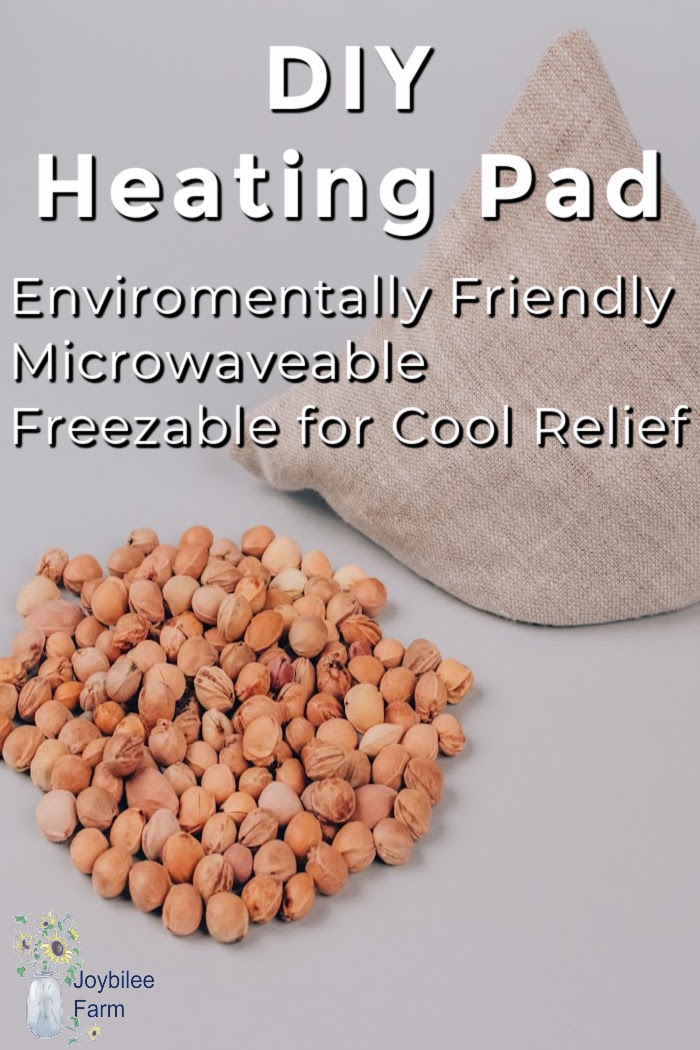
Make your own heating pads — for gifts or for comfort
It started as an odd sock, filled with wheat and tied at the top. We popped these in a make-shift double boiler and heated them on the woodstove for cold-weather comfort at the foot of the bed. The sock was too short and stumpy and didn’t drape quite the way we needed it on cold nights. The ideal heating pad is long and bendable to fit around the back of the neck, across the chest, or over the tummy. Like the ember pan or the hot rocks, warmed in the fireplace in pioneer times, these heating pads can prewarm winter beds and comfort fussy babies. Each of my children had their own heating pad to take to bed with them. Yesterday, Mr. Joybilee even took one to work to warm up a co-worker’s hands in the office. Today I’m stitching up a quick hand-size one, filled with flaxseed and lavender, for her. The office is a bit cold this week and chilblains can make typing difficult.
What are the best filling materials for heating pads?
The first time I made heating pads I filled them with beans as the wheat berries didn’t retain the heat very long. The beans smelled like farts. Seriously, they were not conducive to relaxation. And although they were larger than wheat, they didn’t seem to hold the heat in any longer. When I was making cherry liqueur last July I saved the cherry pits, boiled them to remove the pulp and dried them in the bottom of the dehydrator, as I was drying out summer harvest, to dry them thoroughly. I saved them for this project.
Cherry pits, like flaxseeds, are small and have a small amount of oil in the centre to hold the heat. Heating pads, also called “comfort bags,” made with cherry pits are lighter weight than flax bags, for those times when you don’t want something heavy on your neck. But if you don’t have any cherry pits right now, save this for next July and use flaxseeds in this project. Both flaxseeds and cherry pits will hold in the heat and give back their comfort to achy necks, cold feet, cramping tummies, and cold, shivery shoulders.
Use heating pads for:
menstrual cramps
neck pain
cold feet
cold beds
aching backs
sore joints
cold hands
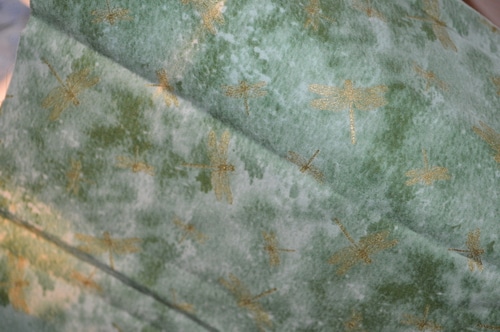
Make an easy neck heating pad – a beautiful gift for a friend
Materials for a heating pad and 2 pairs of hand warmers:
4 cups of cherry pits or flaxseeds
1 fat quarter in pretty 100% cotton fabric
Matching thread
If you’ve got some well-cleaned pits leftover from your syrup making, place the pits in your dehydrator on the bottom shelf, while you are drying other fruits and vegetables. Allow them to dry completely over several days.
Prepare the cherry pits
Dry scrub them clean of any residual cherry debris, using a stiff brush or scrubby pad. Dry again if necessary.
Cut the fabric along the grain
A fat quarter will make two long neck heating pads or 1 neck heating pad and two pairs of hand warmers. Cut the fat quarter in half to get two pieces 10 inches by 22 inches. One piece 10 inches by 22 inches is enough for one long heating pad. Cut your fat quarter 10 inches wide by 20 inches long – for a neck warmer or 10 x 5 inches for a pocket/hand warmer.
I measure with a ruler along the selvedge edge and then make a small cut perpendicular to the edge. Then I tear along the cut to tear with the grain of the fabric. It’s a fast and easy way to keep the grain of your fabric in line and prevent twisting and warping in your final project.
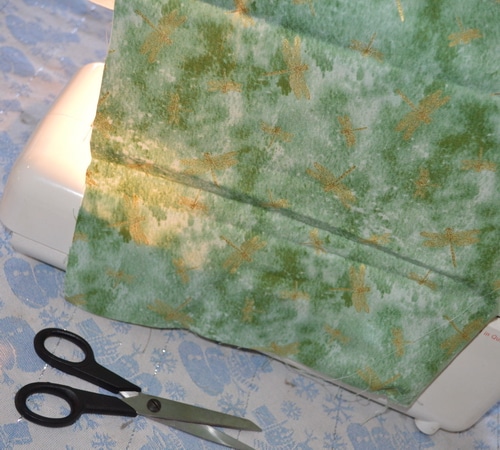
Stitch the fabric into a bag
Fold the cloth in half lengthwise, right sides together. Stitch across the bottom and along the long side, making a ¼ inch seam. Leave the short side open. Reinforce the seam with a zigzag or overlock stitch over the raw edge. Turn the bag right side out. Press the seams.

Make three channels in the bag
Make three channels in the bag by stitching, a straight stitch, 1.25 inches from each side of the bag, leaving the last inch at the top of the bag free of stitching. You’ll make two lines of stitches for three channels in the bag.

Fill the bag
Fill the bag with clean, dry, cherry pits or whole flaxseed. One bag will use 3 cups of flaxseed. Each pair of handwarmer uses 1/3 to 1/2 cup of flaxseed. Use a funnel to get the pits into all three channels of the bag.
Add three cotton balls, with 5 drops of lavender essential oil to each cotton ball. Stuff the cotton ball into the centre of each channel while filling with cherry pits or flaxseed. (Don’t use polyester balls – only cotton, silk, or natural wool balls. Wool batting will also work.)
Fold over the top of the bag all the way around. Stitch along the open seam using a whip stitch to seal the bag.
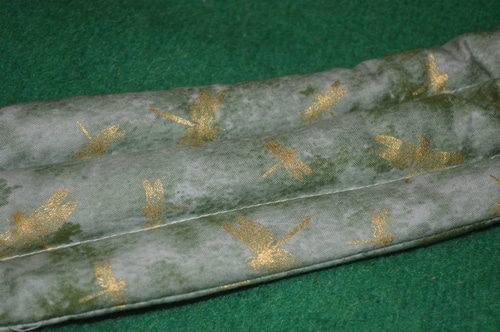
Other filling materials
You ran out of cherry pits and you want to make more bags? Try Flaxseed, maize (don’t use popcorn), buckwheat hulls, wheat, rye, or barley berries. Cherry pits and flaxseed have oil that retains heat longer than grains that have a higher moisture content. Grains and beans also smell bad or slightly off when heated in the microwave repeatedly, but cherry pits and flaxseed don’t become odorous with repeated heating.
Instructions to use the bag:
Place the heating pad in a plastic Ziploc bag. Microwave the bag on high for 60 to 90 seconds, depending on the power of your microwave. (Smaller hand warmers should be heated for no more than 35 seconds in the microwave.) Alternatively, place the protected bag in a pot on your woodstove, inside another pot like a double boiler but protect it from steam. Steam will alter the moisture content of the stuffing. Remove from the heat source and place the bag across your shoulders or on your sore neck. It will warm your muscles and soothe them. Add a few drops of lavender essential oil to the cloth after microwaving or heating. It will release its lavender goodness and help you relax.
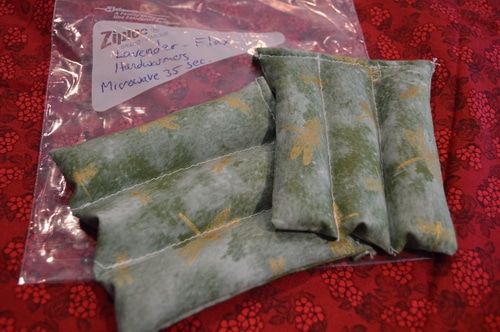
Gift-giving suggestion:
Place this neck heating pad, a bottle of cherry liqueur, and a mason jar of cherry syrup, or cherry-infused honey, into a pretty willow basket, along with a pair of crystal liqueur glasses from the thrift shop. Add a small bottle of lavender essential oil. Wrap it all up in a cherry-coloured fabric, Japanese style.


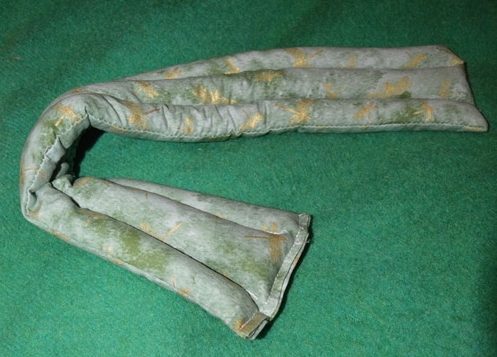

Does your camper have an oven? You could use a dutch oven and put a steel colander inside to hold the heat bag. You’d have to watch that it didn’t catch fire. But if you made it out of cherry pits, rice, or cow corn, you could steam it in the dutch oven by adding an inch or two of water. Flax will go jello-like if you steam it though, so if you plan to steam the bag, don’t use flax.
If you were somewhere sunny, you could create a solar heater using cardboard and tinfoil. Again watch the temperature so that you don’t burn the bag.
Chris, Hopefully you can answer a question about heating a cherry pit (or flax seed) bag for me. I am a disabled veteran who needs to ice and heat past injuries quit often. No problem at home with a micro-wave but I travel a lot with my self-contained camper. I am usually parked where there is no 110V electrical service so am wondering how to heat the bag using just my camper propane cooking stove. In the “old” days, they must have heated them somehow on wood-burning stoves. Can you fill me in on how to go about it in my camper when off-grid. Thanks…and thanks for the article. John
Use flax seed instead of cherry pits if you don’t have cherry pits handy.
Sounds great! Unable to obtain a cherry bush, and managed to buy a container of fresh cherries from Woollies. Can the pits be used to propogate plants and if so is there a special germinating process needed. Couple months ago bought microwaveable depilatory wax. Kaboem and sparks the microwave arced and blew. Ha ha